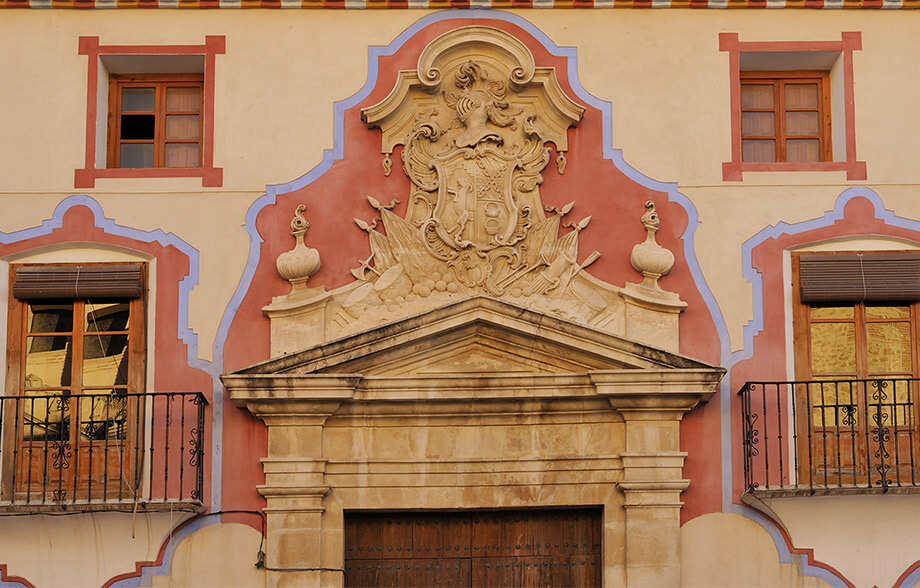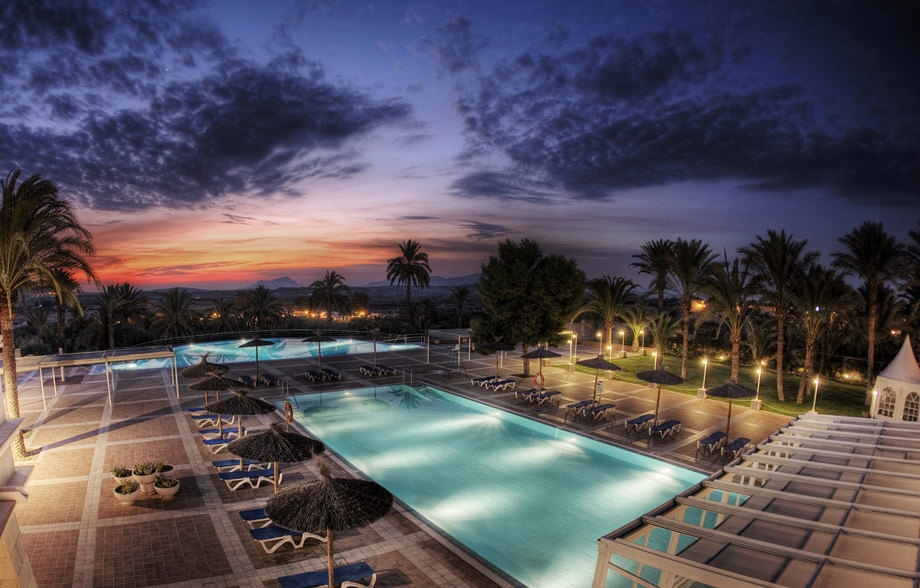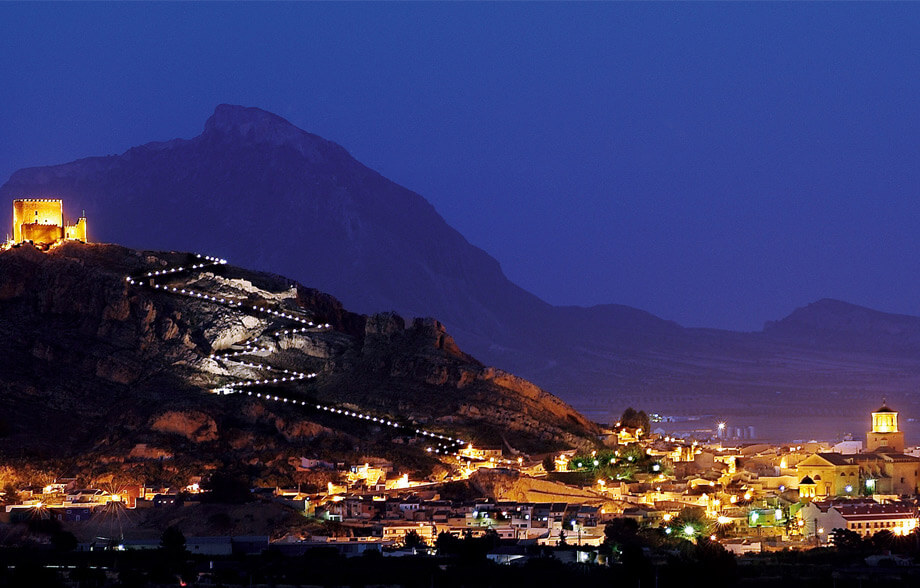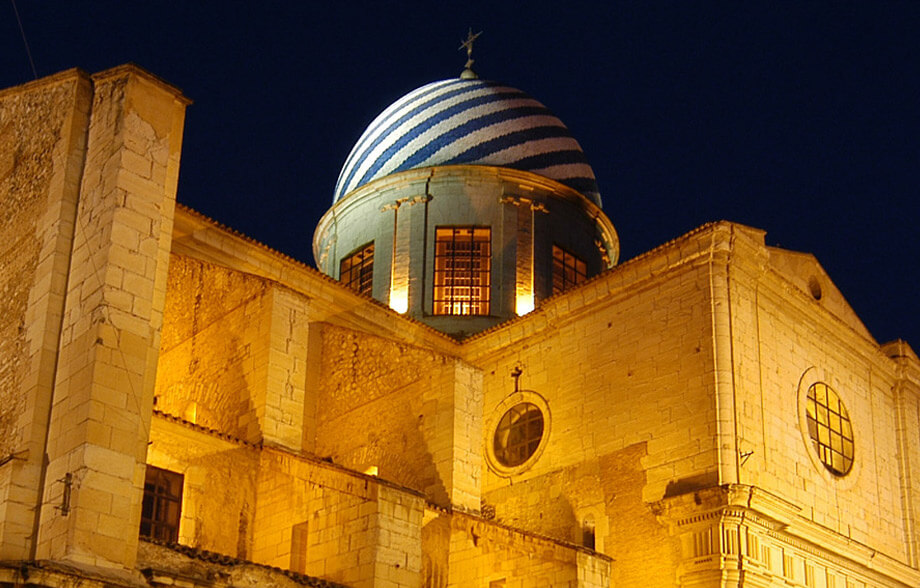ALTIPLANO
The Altiplano Region takes us into 'Castilian' Murcia, an area of sprawling fields that betoken the proximity of the plains of La Mancha. This landscape meets the eyes of the visitor with its ubiquitous vineyards (the winegrowing areas of Jumilla and Yecla), towns steeped in history and tradition such as Abanilla, or the generous hot springs of Fortuna. The possibilities offered by this region are plentiful. One curious option is to visit the archaeological sites from the Bronze and Middle Ages, and Roman times, as well as a curious collection of Iberian artefacts.VENDIMIA AND TRADITION
The breeze from the nearby Sierra de El Carche refreshes the heat of Jumilla's vine-covered territory, with its fiestas such as the Vendimia, or Grape Harvest. Yecla too, in the shadow of its emblematic Monte Arabí, is drawn into this festive tradition when in December the town pays homage to the Virgin, or Purísima, amidst the purifying rituals of gunpowder and harquebusades. Everyone is welcome.Top 10
It is said that the Northeast is like a Castilian knight: elegant and filled with nobility. This area of countless possibilities has broad plains, vineyards and magnificent mountain ranges; it is proud of its history, culture and festivities.
WINE ROUTES
The Northeast serves as an excuse to come to the interior of the region and enjoy great wines and experiences. To be more precise, the wines from Jumilla and Yecla -both with a Guarantee of Origin- are the leitmotif in our routes including visits to wineries, museums and wine cellars, wine tastings, walks through some vineyards, workshops, concerts, and numberless activities to make your stay an unforgettable episode. A trip reserved for gourmets.
FOR EPICUREANS
The Northeast offers delicious rice dishes and gazpachos, grilled meat and cold cuts, good wines such as those from Jumilla and Yecla, and typical pastries such as aniseed ring-shaped pastries, pirusas and sequillos. It is one of those places where the gastronomic wisdom has been marked by centuries of history and traditions. The wisest thing to do is not wander anymore, sit down and taste our delicacies.
THERMAL WATERS
In Fortuna is the balneario -thermal spring spa- of Leana, which is among the oldest of its kind in Spain. Rebuilt on Roman baths, it constituted the area's biggest healing centre at its time, together with the Cueva Negra -Black Cave- sanctuary, famous for its Tituli Picti. Previous peoples, such as the Iberians and Greeks, also knew about the healing properties of these waters. If everybody continues to come here in order to recharge batteries, it must be for a reason.
JUMILLA CASTLE
This castle, commissioned by the Marqués de Villena in 1461 and built on a Muslim fortification, is nowadays a restoration example and a busy cultural centre. In order to get to it, you should go through the Camino del Subidor, a natural viewpoint from which you will enjoy one of the most amazing panoramic views in the region. It has been declared a National Monument.
MAGIC MOUNTAINS
One of Yecla's most appreciated natural settings is Monte Arabí. Known as the magic mountain, this spectacularly beautiful place is supplemented by many legends and myths. It is really worth going on a trip in order to admire these wonderful landscapes. The walls of the Cantos de la Visera and the Cuevas del Mediodía still conserve some Neolithic cave paintings. Moreover, among Yecla, Jumilla and Fortuna are the regional parks of Sierra del Carche and Sierra de la Pila, where you can enjoy astonishing geological formations, nature routes, hang gliding, paragliding...
IS IT AN ORIGINAL OR A COPY?
El Greco Replica Museum in Yecla has a collection of 73 oil paintings; all of them are shown on the second floor of the locality's Municipal House of Culture in the Ortega House-Palace. If you come and see works such as 'The Apostolate', 'The Despoilment' and 'The Nobleman with his Hand on his Chest', you will probably doubt whether they are replicas or not.
DRESS COATS AND TWO-CORNERED HATS
A great uproar of drums and harquebus announces the arrival of hundreds of tiraores -shooters- wearing dress coats and two-cornered hats. These are the Patron Saint's Day Celebrations in Yecla, declared to be of National Tourist Interest. These celebrations -which are more than 350 years old- take place in December every year, honouring the Virgen del Castillo and thanking Her for the safe and sound return of the people from Yecla who fought in the War of the Spanish Succession.
THE CROSS AND THE CRESCENT
If you are lucky enough to come to Abanilla towards the end of April and the beginning of May, you can participate in the Festivities Honouring the Holy Cross and of Moors and Christians, which are among the most traditional ones in the whole region. It is worth watching the colourful parades while listening to the pasodoble, witnessing the salute of the harquebusiers, or going in a procession with the Holy Cross to Mahoya Hermitage among the cheers, emotions and promises of the crowd. These festivities have been declared to be of Regional Tourist Interest.
A STRANGE SYMBIOSIS
In mid-August, Fortuna is invaded by legions of Iberians and Romans, nymphs, ballerinas, fire eaters and mythical characters. The Iberian-Roman Sodales Festivities, which are celebrated to honour San Roque and where some historical passages are recreated, have their high points at the Kalends of August, the Pursuit of the Lucerne and the magnificent parade of August 15th, declared to be of
PAGAN AND SACRED RED WINE
Coinciding with the Grape Harvest, the Ntra. Sra. de la Asunción Festivities are celebrated in mid-August in Jumilla: thousands of wine litres and typical products are distributed among the people. According to tradition, everybody wears a white shirt which will be dyed purple as the day goes on. Very important too is the locality's Holy Week, declared to be of National Tourist Interest. It stands out for the solemnity of its processions of a Franciscan origin, its proclamations and its procession starting at Santa Ana Monastery.





